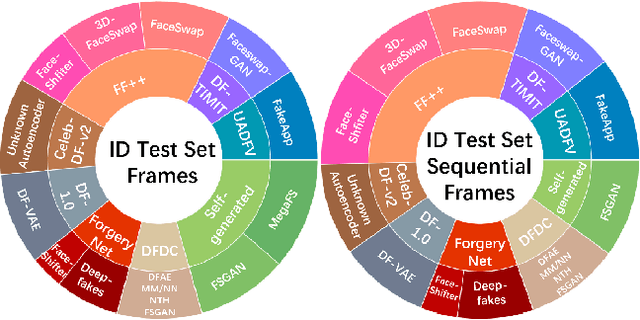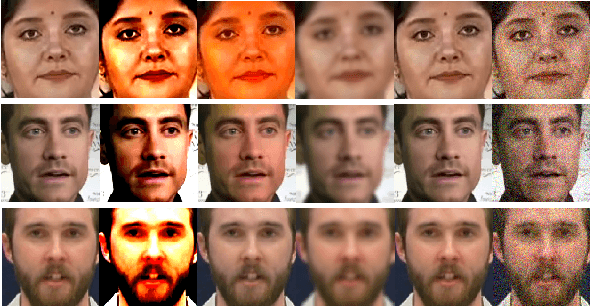Pengbin Hu
End-to-end Face-swapping via Adaptive Latent Representation Learning
Mar 07, 2023Abstract:Taking full advantage of the excellent performance of StyleGAN, style transfer-based face swapping methods have been extensively investigated recently. However, these studies require separate face segmentation and blending modules for successful face swapping, and the fixed selection of the manipulated latent code in these works is reckless, thus degrading face swapping quality, generalizability, and practicability. This paper proposes a novel and end-to-end integrated framework for high resolution and attribute preservation face swapping via Adaptive Latent Representation Learning. Specifically, we first design a multi-task dual-space face encoder by sharing the underlying feature extraction network to simultaneously complete the facial region perception and face encoding. This encoder enables us to control the face pose and attribute individually, thus enhancing the face swapping quality. Next, we propose an adaptive latent codes swapping module to adaptively learn the mapping between the facial attributes and the latent codes and select effective latent codes for improved retention of facial attributes. Finally, the initial face swapping image generated by StyleGAN2 is blended with the facial region mask generated by our encoder to address the background blur problem. Our framework integrating facial perceiving and blending into the end-to-end training and testing process can achieve high realistic face-swapping on wild faces without segmentation masks. Experimental results demonstrate the superior performance of our approach over state-of-the-art methods.
Towards Benchmarking and Evaluating Deepfake Detection
Mar 04, 2022



Abstract:Deepfake detection automatically recognizes the manipulated medias through the analysis of the difference between manipulated and non-altered videos. It is natural to ask which are the top performers among the existing deepfake detection approaches to identify promising research directions and provide practical guidance. Unfortunately, it's difficult to conduct a sound benchmarking comparison of existing detection approaches using the results in the literature because evaluation conditions are inconsistent across studies. Our objective is to establish a comprehensive and consistent benchmark, to develop a repeatable evaluation procedure, and to measure the performance of a range of detection approaches so that the results can be compared soundly. A challenging dataset consisting of the manipulated samples generated by more than 13 different methods has been collected, and 11 popular detection approaches (9 algorithms) from the existing literature have been implemented and evaluated with 6 fair-minded and practical evaluation metrics. Finally, 92 models have been trained and 644 experiments have been performed for the evaluation. The results along with the shared data and evaluation methodology constitute a benchmark for comparing deepfake detection approaches and measuring progress.
 Add to Chrome
Add to Chrome Add to Firefox
Add to Firefox Add to Edge
Add to Edge